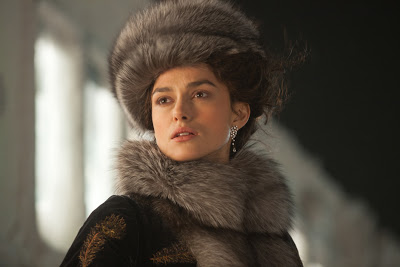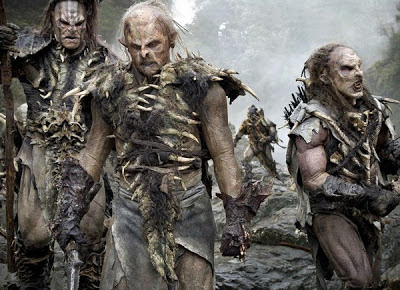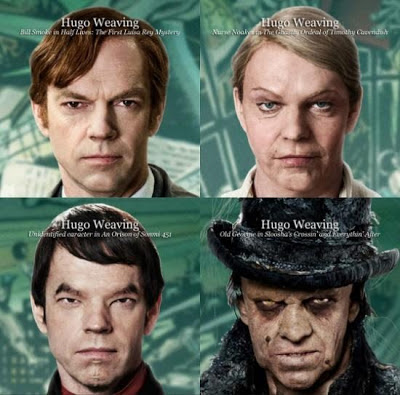Why group these three categories together? Because they all award craftsmen whose job is to make their movies look prettier? Or because I just randomly decided to lump three categories into a single post? As Yoda would say, it matters not. Let’s get to it.
BEST VISUAL EFFECTS
NOMINEES
The Avengers
The Hobbit: An Unexpected Journey
Life of Pi
Prometheus
Snow White and the Huntsman
WILL WIN
Life of Pi‘s only competition here is itself. The movie’s visual effects are so good – by which I mean they’re so beautifully rendered and subtly deployed – that voters might not even recognize that they’re watching computer-generated imagery at all. Then again, even the most blockheaded Academy member is unlikely to be so obtuse as to actually believe that Ang Lee put a real tiger in a boat with a 19-year-old kid and then just let the cameras roll. There’s also the obscure point of trivia that a Best Picture nominee has lost the Best Visual Effects Oscar to a non-Best Picture candidate only once in the category’s 49-year history. That’s a slightly misleading stat, as no Best Picture contender was even in the running for Best Visual Effects in 22 of those years, but it’s still something.
And again – and more importantly – I’m not sensing even the slightest predatory whiff from any of the tiger’s rivals. The Avengers, The Hobbit: An Unexpected Journey, and Prometheus all feature commendable effects work, but that work hardly stands out in today’s era of perpetual technological magnificence. And Snow White and the Huntsman seems to be here for no other reason than its (admittedly impressive) transplantation of a septet of well-known British actors’ heads onto the bodies of dwarves. None of the four challengers features a gasp-worthy, “Holy shit, did you see that?” moment that will have audiences buzzing as they leave the theatre.
Life of Pi, by contrast, doesn’t just feature that gasp-worthy moment – it extends it for upwards of an hour. You may not remember the movie’s muddled spiritual themes or its sagging epilogue, but you will remember that tiger. And that’s more than enough to earn it the Oscar.
SHOULD WIN
The problem with modern visual effects is not, in empirical terms, that there’s a problem at all. Visual effects in contemporary movies are very good and getting better. The issue is that the bar has already been set so astronomically high – thanks most recently to the astounding artistry and innovation on display in pictures such as Avatar, Inception, and Rise of the Planet of the Apes – that it’s becoming exponentially more difficult for V/X crews to truly wow their audiences. We’re like fans of UCLA during the Wooden dynasty, when even winning the national championship became mundane.
And so, as I suggested previously, the special effects of The Avengers, with its flying aircraft carriers and speeding superheroes, are thoroughly impressive but not especially memorable. The same is true of the majority of the V/X work in The Hobbit: An Unexpected Journey, with the notable exception of Andy Serkis’ Gollum, who looks as lifelike and spindly as ever but nevertheless evades the uncanny valley. Prometheus does create an extraordinary new world that makes you want to breathe in its air (if it were breathable), but I credit the production designers and director Ridley Scott’s overall invocation of awe more than the binary code. As for Snow White and the Huntsman, those dwarves look reasonably realistic (at least once you get past the inevitable “Wait a minute, isn’t that Ian McShane?” reaction), but one well-executed gimmick is hardly cause for Oscar recognition.
Thankfully, Life of Pi provides yet another historic advancement in the realm of visual effects, and that advancement’s name is Richard Parker. He’s the computer-generated tiger, of course, but it feels more appropriate to refer to him by name than by species given the sheer magnitude of personality he exudes. As a digital creation, Richard Parker is utterly sublime, with rippling fur and a true sense of weight and space. But watching him stake out his corner of the lifeboat in Life of Pi, audiences will spend little time marveling at the gleam of his sharp teeth or the agility of his prowling movements. They will be too busy engaging with him, whether afraid that he’s going to devour the movie’s main character or sympathetic that he’s just another wayward soul searching for home. The point is that Richard Parker is more than a visual effect – he’s a character. And that’s why he’s a great effect.
MY IDEAL BALLOT
The Avengers
Chronicle
John Carter
Life of Pi
Rust and Bone
Chronicle exhibits extraordinary subtlety in its seamless depiction of telekinesis, which is critical given the importance of levitation to the film’s central conceit. Rust and Bone reminds us that special effects can play a vital and valuable role in cinema that exists outside the world of big-budget Hollywood spectacle. John Carter, meanwhile, stands as an opposing reminder of sorts, a big, brawling blockbuster whose top-notch digital wizardry hypnotically draws viewers into its richly realized, decidedly new universe.
My ideal winner: Life of Pi.
BEST COSTUME DESIGN
NOMINEES
Anna Karenina
Lincoln
Les Misérables
Mirror Mirror
Snow White and the Huntsman
WILL WIN
Unlike with Best Visual effects, the winners of Best Costume Design exhibit virtually no correlation with Best Picture. In fact, The Artist‘s victory in this category last year broke a string of six consecutive telecasts in which the winner wasn’t even nominated for the top prize. So while it might initially be tempting to elevate Lincoln and Les Misérables to the top of the pack, the more prudent approach is to focus on the quality of the costumes themselves.
Unfortunately, separating the contenders from pretenders is quite difficult; all possess hallmarks of an award-winner (and all, for that matter, are either period or fantasy films), but none cries out for the statuette. Lincoln, in spite of his prestige pedigree, is possibly the weakest candidate here, as its parade of men in top hats and tails may be grudgingly accurate but is hardly beautiful. And the nineteenth-century wardrobe of Les Misérables is similarly drab. In general, the Academy tends to prioritize sumptuous design over period precision, and neither Best Picture nominee offers the former.
Snow White and the Huntsman does feature its share of impressive threads, most notably in the various gowns that cling to Charlize Theron like shimmering barnacles, but the overall color scheme of the movie is likely too dark compared to Oscar’s preferred palette. Mirror Mirror, in contrast, dazzles viewers with a plethora of bright dresses and ornate blouses. Still, I suspect that the Academy will ultimately be seduced by Jacqueline Durran’s supremely elegant costumes for Anna Karenina, a distinguished period picture that just happens to feature a number of attractive women donning flamboyant, ruff-laden outfits. Its powerful combination of stateliness and flair should have voters salivating. Not that I have anyone in mind.
(And yes, it helps when the most beautiful woman in the world models your costumes for you.)
SHOULD WIN
For most categories, my foregoing analysis in the “Will Win” section varies markedly from my own evaluations of the field’s nominees. That’s because my studious stargazing requires me to place myself in the perspective of a typical Academy voter, a perspective that rarely aligns with my own. With Best Costume Design, however, my opinions are virtually identical to those of my hypothetical AMPAS member. To wit, the wardrobe exhibited in Lincoln and Les Misérables is suitably tasteful but hardly revelatory; similarly, notwithstanding the Wicked Queen’s savagely sexy attire, the warrior garb featured in Snow White and the Huntsman is serviceable but forgettable.
Mirror Mirror at least features colors that pop off the screen, and its vivid threads do well to advance the movie’s sense of impish playfulness. But the costumes on display in Anna Karenina are flat-out knockouts. The film’s wardrobe is undeniably pleasing to the eye, but it’s also singularly evocative of a particular time and place. Indeed, one of the central paradoxes of Anna Karenina, at least in a cinematic sense, is how a movie about death, depression, and suffocation can feel so alive and look so breathtakingly beautiful. But that’s a thematic question for a different day. This category is about the costumes, and they’re pure gold.
MY IDEAL BALLOT
Anna Karenina
Farewell, My Queen
John Carter
Mirror Mirror
Moonrise Kingdom
Farewell, My Queen lifts Anna Karenina‘s conceit and multiplies it to fit the scale of revolutionary France; it’s a film in which opulence entwines with rot, and its ravishing wardrobe somehow underscores its characters’ hopelessness. John Carter‘s visual effects are its primary calling card, but its distinctive costumes further substantiate the depth of the movie’s scope and originality. The myriad stylings displayed in Moonrise Kingdom emblazon the film with Wes Anderson’s unique stamp but also deftly recall universal memories of childhood.
My ideal winner: Anna Karenina.
BEST MAKEUP AND HAIRSTYLING
NOMINEES
Hitchcock
The Hobbit: An Unexpected Journey
Les Misérables
WILL WIN
Hell if I know. But curiously, each of these movies features its own brand of recognizable, Oscar-centric makeup. Hitchcock puts the typically gaunt Anthony Hopkins in a fat suit. The Hobbit: An Unexpected Journey applies a bevy of grotesque ornaments – along with bushels of facial hair – in order to create its many misshapen faces. And Les Misérables ages its main character over a span of several decades (remember that Barney’s Version nabbed a nomination here for speculating as to just how many wrinkles Paul Giamatti’s face would sport once he reached 70).
So who wins? I’ll take a “more is more” approach and go with The Hobbit. Say what you want about the movie, but there sure was a lot of it, makeup included.
SHOULD WIN
The problem with weighing the merits of a movie like Hitchcock in this category is that it’s difficult to separate the work of the makeup artists from those of the primary artist (that is, the actor). The Academy faced a similar conundrum last year with The Iron Lady, but the makeup there was so startlingly transformative that it was clear that Meryl Streep’s likeness as Margaret Thatcher wasn’t just a result of the actress’ uncanny impersonation. Here, however, I’m more partial to credit Hopkins’ gruff, growling performance as the reason he so effectively inhabits the master of suspense. And because, as with the film’s costumes, Les Misérables‘ makeup is solid but little more, that leaves me with The Hobbit, and while I may have arrived at my choice through process of elimination, it’s a reasonably worthy winner. Look at it this way: Either the makeup work was entirely convincing, or else Peter Jackson magically transfigured half of the population of New Zealand into a bunch of orcs. (Not that we should rule the latter out.)
MY IDEAL BALLOT
Cloud Atlas
Holy Motors
Looper
If Hitchcock earned its nomination for turning Hopkins into one particular character, Holy Motors surely deserves recognition for having the audacity to mutate lead actor Denis Lavant into no fewer than eleven distinct personalities. Looper, meanwhile, casts the wiry Joseph Gordon-Levitt and the brawny Bruce Willis as the same character and gets away with it, and the makeup contributes significantly in that regard.
Cloud Atlas has been stupidly criticized for its use of white actors to play Asian characters (a critique rendered all the more vacant when considering that the movie also employs the same technique in reverse), but regardless, the makeup – which allows seven different actors to play radically different characters across six different time periods – is mind-blowing. More importantly, it’s effective. Yes, there are moments when the audience recognizes the meta concept, but that recognition is intentional, as it provides with filmmakers with a silent avenue to communicate their theories on the universality of the human condition (trust me, it’s far less dry than it sounds). Brilliant stuff.
My ideal winner: Cloud Atlas.
Jeremy Beck is the editor-in-chief of MovieManifesto. He watches more movies and television than he probably should.



